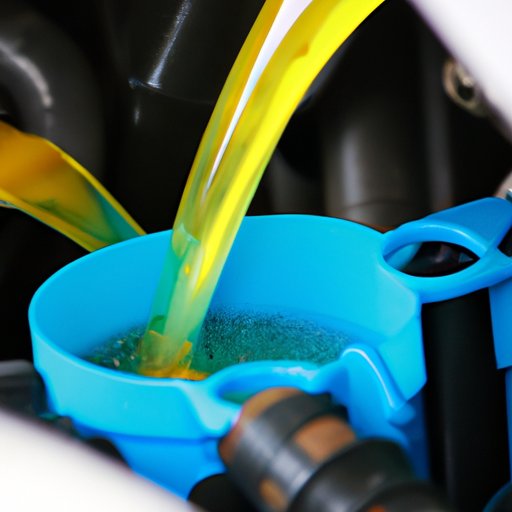
Introduction
Have you ever wondered if you can mix different coolant colors in your car’s engine cooling system? Maybe you’ve tried mixing them to save some money or simply because you thought it was ok. Unfortunately, mixing coolant colors is a common problem that many car owners face. In this article, we’ll explore the risks associated with mixing coolant colors, the science behind it, and how to properly maintain your car’s engine cooling system to avoid the issue altogether.
Why Mixing Coolant Colors Is a Bad Idea: An In-Depth Analysis
The potential problems associated with mixing coolant colors are numerous. One of the main issues is that different coolant colors have different chemical compositions that are incompatible with one another. As a result, mixing different coolant colors leads to the formation of sludge, deposits, and other contaminants that can damage the engine cooling system over time.
For example, if you mix green and orange coolant, the resulting mixture may have a higher acidity level than what your engine can tolerate, leading to corrosion of metal components in the cooling system. Additionally, the mixture may lose its anti-corrosion properties, leading to rust and other forms of damage that can cause cooling system leaks and overheating.
The Dangers of Combining Different Coolant Colors in Your Car
Mixing different coolant colors can lead to various dangers in your car’s engine. For instance, it can cause clogging of the radiator and the heater core, leading to poor heat transfer and engine overheating. It can also cause damage to the engine’s water pump, causing leaks, and eventually engine failure if not addressed promptly.
Can You Mix Coolant Colors? What the Experts Say
According to experts in the automotive industry, it is not safe to mix different coolant colors. Doing so can lead to various engine problems that can be costly to repair. Therefore, it is recommended to always use the coolant specified in your car’s owner’s manual and to avoid mixing it with other colors. If you’re unsure if you can mix a particular coolant with another, it’s always best to consult an expert to avoid costly mistakes.
Debunking Common Myths About Mixing Coolant Colors
There are many myths surrounding the issue of mixing coolant colors that car owners need to be aware of. One of the most common myths is that you can mix different coolant colors as long as they are of the same type, like two green coolants. However, this is not entirely true, as different coolant brands can have different chemical compositions that can lead to incompatibility when mixed. Another myth is that you can mix different coolants if you flush the system beforehand. While flushing the system can remove contaminants, it does not change the chemical composition of the coolant.
The Science Behind Different Coolant Colors and Their Compatibility
The different colors of coolants are usually the result of different chemical compositions and additives. Green coolants, for instance, contain Ethylene Glycol as their primary ingredient and silicate-based additives to prevent corrosion. Orange coolants, on the other hand, contain Organic Acid Technology (OAT) and other additives to prevent corrosion. Mixing these two coolant types can have serious adverse effects on your engine.
It’s essential to note that there are some exceptions to the mixing rule. For instance, some leading coolant manufacturers produce Universal coolants that can be mixed with any other coolant type without negative effects. If you’re unsure whether a particular coolant can be mixed with another, it’s always best to consult an expert or stick to the coolant specified in your car’s owner’s manual.
What Happens When You Mix Different Coolant Colors
If you mix different coolant colors, you’ll likely end up with a mixture that has an unpredictable chemical composition that could damage your engine over time. Mixing different coolant colors can cause the formation of deposits, sludge, and other contaminants that can clog the cooling system, leading to poor heat transfer and eventual engine overheating. Mixing different coolants can also cause damage to the radiator, water pump, and heater core, which can be costly to repair or replace.
How to Properly Maintain Your Car’s Engine Cooling System and Avoid Color Mixing
The key to avoiding the dangers of mixing coolant colors is to ensure that your car’s engine cooling system is adequately maintained. Regular flushing and changing of the coolant at recommended intervals can help prevent the formation of deposits and other contaminants that can damage your engine. Additionally, always use the coolant specified in your car’s owner’s manual and avoid mixing it with other colors. If you must add coolant, make sure it’s the same brand and type that’s already in the system. Sticking to these simple maintenance procedures can help keep your engine running smoothly and prevent unnecessary damage and costly repairs.
Conclusion
Mixing coolant colors can lead to various problems that can be costly to repair. Always use the coolant specified in your car’s owner’s manual and avoid mixing different colors. Following simple maintenance procedures such as regular flushing and changing of the coolant, and consulting an expert when unsure, can help ensure that your engine stays in tip-top condition. Taking proper care of your car’s engine cooling system is essential to avoid issues and keep your car running smoothly for years to come.





